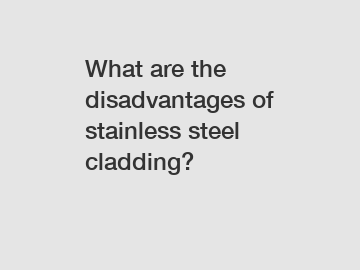What are the disadvantages of stainless steel cladding?
Stainless steel cladding is a popular choice for both residential and commercial buildings, as it offers a sleek and modern appearance while also providing durability and resistance to corrosion. However, like any building material, there are disadvantages to using stainless steel cladding that must be considered before making a decision on whether or not to incorporate it into your design.
One of the main disadvantages of stainless steel cladding is its cost. Stainless steel is a high-quality material that is more expensive than other cladding options, such as aluminum or vinyl. This can significantly increase the overall cost of a construction project, which may be a deterrent for some builders or homeowners who are working within a tight budget. In addition to the initial cost of purchasing the stainless steel cladding material, installation costs can also be higher due to the specialized tools and expertise required to properly work with stainless steel.
Another disadvantage of stainless steel cladding is its susceptibility to scratching and denting. While stainless steel is known for its durability and resistance to corrosion, it is not completely immune to damage. Scratches and dents can easily occur from accidental impacts or abrasive cleaning methods, which can detract from the overall appearance of the building. Additionally, once a scratch or dent has occurred, it can be difficult and costly to repair, as stainless steel is not as easily malleable as other cladding materials.

Stainless steel cladding also requires regular maintenance to keep it looking its best. While stainless steel is resistant to corrosion and rust, it can still become dirty and stained over time if not properly cared for. Regular cleaning with mild soap and water is necessary to remove dirt, grime, and other debris that can accumulate on the surface of the stainless steel. Failure to properly clean and maintain stainless steel cladding can lead to a dull and unattractive appearance, which can detract from the overall aesthetic of the building.
In addition to regular cleaning, stainless steel cladding may also require periodic polishing to maintain its shine and luster. Over time, stainless steel can become dull and lose its reflective quality, especially in harsh environmental conditions or high-traffic areas. Polishing stainless steel can be a time-consuming and labor-intensive process that may require the use of specialized equipment and techniques. This can add to the overall maintenance costs of using stainless steel cladding on a building.
Another disadvantage of stainless steel cladding is its limited color options. While stainless steel is available in a range of finishes, such as brushed or polished, it is primarily a silver-colored material. This can be limiting for builders or designers who are looking for a wider variety of color options to match the aesthetic of a building. While there are some options for coloring stainless steel through processes such as powder coating or painting, these methods can be costly and may not provide the same level of durability as the natural stainless steel finish.
Lastly, stainless steel cladding can be a poor insulator compared to other cladding materials such as wood or vinyl. Stainless steel has a high thermal conductivity, which means it can easily transfer heat or cold from the exterior of a building to the interior. This can result in increased energy costs for heating and cooling, as the building may require more energy to maintain a comfortable temperature. Additionally, poor insulation can result in condensation forming on the interior walls, which can lead to moisture damage and mold growth over time.
In conclusion, while stainless steel cladding offers many benefits, such as durability, resistance to corrosion, and a modern appearance, there are also several disadvantages to consider before incorporating it into a building design. From its high cost and susceptibility to damage, to the need for regular maintenance and limited color options, stainless steel cladding may not be the best choice for every project. Builders and designers should carefully weigh the pros and cons of using stainless steel cladding to determine if it is the right fit for their needs.
Want more information on 201 Stainless Steel Plate Price, hastelloy plate, 304 Stainless Steel Plate Manufacturer? Feel free to contact us.


